Canon EOS-1V HS User Manual
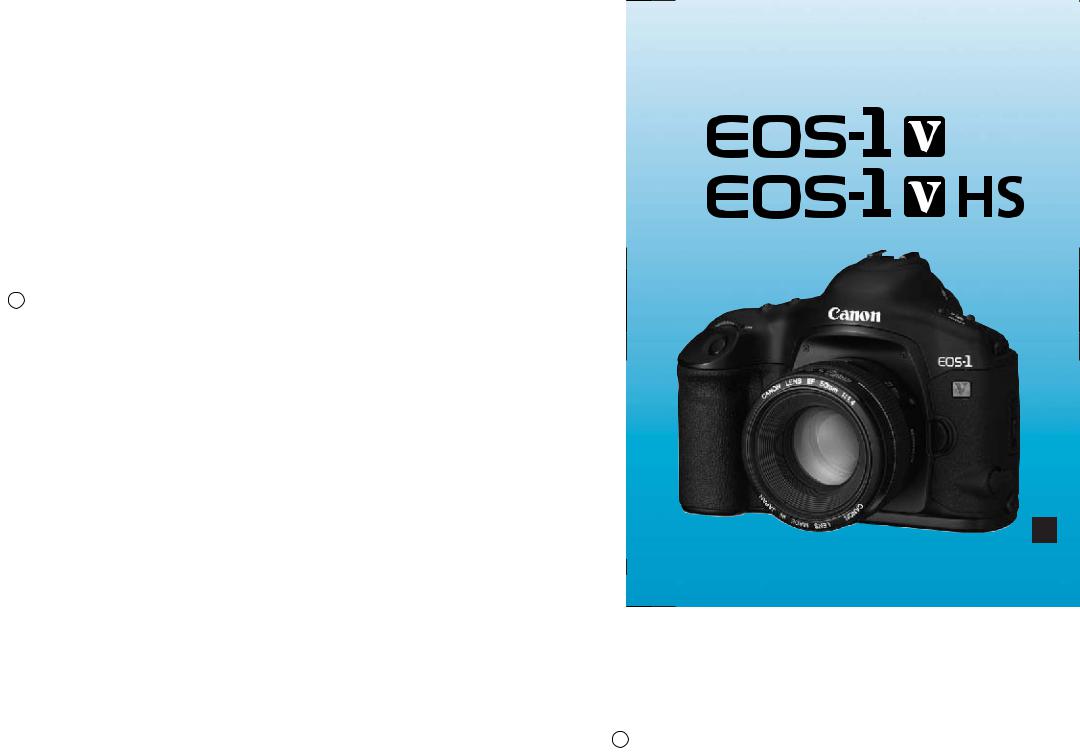
E
English Edition
INSTRUCTIONS


Thank you for purchasing a Canon product.
The EOS-1V is a high-performance autofocus single-lens reflex camera equipped with high-precision Area AF.
Photograph a wide variety of subjects under almost any condition. Let the camera do everything automatically or take full control. In any case, operation is simple with the electronic dials.
Before taking pictures, read this instruction booklet and familiarize yourself with your new camera.
■Symbols
The Caution symbol alerts you to actions to prevent picture-taking problems.
The Note symbol gives additional information for basic camera operation.


 The Light bulb symbol offers helpful tips for operating your camera or taking pictures.
The Light bulb symbol offers helpful tips for operating your camera or taking pictures.
Read “Handling Precautions” on page 6 to prevent camera malfunction and damage.
Keep this instruction booklet handy for easy reference.
■Precautions
•Before using the camera for an important event, be sure to take test shots to make sure the camera operates properly.
•EOS cameras have a lens mount for dedicated operation (autofocusing, exposure control, etc.) with EF lenses. Using a non-EF lens with an EOS camera may result in improper camera or lens operation.
Note that the warranty does not cover any camera malfunction or damage occurring with the use of non-Canon accessories.
3

Contents 
Handling Precautions ................................................................ |
6 |
Nomenclature ............................................................................ |
8 |
Conventions Used in this Instruction Booklet .......................... |
12 |
1 Before You Start .............................................................. |
13 |
Basic Operation....................................................................... |
14 |
Installing the Battery and Checking the Battery Level............. |
19 |
Mounting and Detaching a Lens.............................................. |
21 |
Dioptric Adjustment ................................................................. |
22 |
Film ID Imprinting .................................................................... |
22 |
Loading and Unloading Film.................................................... |
25 |
2
3
4
Quick Start With Program AE......................................... |
29 |
Holding the Camera ................................................................ |
32 |
Using Autofocus (AF)...................................................... |
33 |
AF Mode Selection .................................................................. |
34 |
Area AF Ellipse and Focusing Points ...................................... |
37 |
Focusing Point Selection......................................................... |
38 |
Focusing Point Registration and Switching ............................. |
42 |
Focusing Point Activation Area ............................................... |
44 |
Focusing an Off-Center Subject .............................................. |
45 |
When Autofocus Fails (Manual Focusing)............................... |
47 |
Metering Modes ............................................................... |
49 |
Selecting a Metering Mode...................................................... |
50 |
Metering Modes....................................................................... |
51 |
5 Shooting Modes .................................................................... |
55 |
Shutter Speed-Priority AE ................................................. |
56 |
Aperture-Priority AE ......................................................... |
58 |
Depth-of-field AE............................................................ |
61 |
Manual Exposure ............................................................... |
65 |
Setting Exposure Compensation............................................. |
67 |
Autoexposure Bracketing ........................................................ |
69 |
AE Lock ................................................................................... |
71 |
4

Contents
Setting the Film Speed Manually............................................. |
73 |
Multiple Exposures............................................................ |
74 |
Bulb Exposures ....................................................................... |
76 |
Single-Frame and Continuous Shooting ................................. |
77 |
Self-timer Operation ................................................................ |
79 |
Depth-of-field Preview ............................................................. |
80 |
Mirror Lockup .......................................................................... |
81 |
LCD Panel Illumination............................................................ |
82 |
Using B/W Infrared Film .......................................................... |
82 |
6 Flash Photography .......................................................... |
83 |
Flash Photography with Speedlite 550EX ............................... |
84 |
Using Other EOS-Dedicated Speedlites ................................. |
93 |
Using Non-Canon Flash Units................................................. |
94 |
7 Custom Functions ........................................................... |
95 |
Selecting and Setting a Custom Functions ............................. |
96 |
Canceling a Custom Function ................................................. |
97 |
Custom Function Settings ....................................................... |
98 |
Personal Functions................................................................ |
111 |
Custom Function Group ........................................................ |
112 |
Recording the Shooting Data ................................................ |
114 |
8 For EOS-1V HS Users.................................................... |
115 |
9 Reference Section ......................................................... |
119 |
Basic Photography Terms ..................................................... |
120 |
Troubleshooting Guide .......................................................... |
122 |
Exposure Warning List .......................................................... |
124 |
Program Line......................................................................... |
125 |
Shutter Speed and Aperture Readouts ................................. |
126 |
Interchanging the Focusing Screen....................................... |
127 |
Major Accessories ................................................................. |
129 |
Major Specifications .............................................................. |
134 |
Index...................................................................................... |
138 |
1
2
3
4
5
6
7
8
9
5

Handling Precautions 
Camera Care and Storage
(1)The camera is a precision instrument. Do not drop it or subject it to physical shock.
(2)This camera is not waterproof and cannot be used underwater. If the camera gets really wet, promptly consult your nearest Canon Service Center. Wipe off any water droplets with a dry cloth. If the camera has been exposed to salty air, wipe with a well-wrung damp cloth.
(3)Do not leave the camera in places prone to excessive heat such as in a car on a sunny day. Excessive heat can cause the camera to malfunction.
(4)The camera contains precision electronic circuitry. Never attempt to disassemble the camera.
(5)Use only a blower brush to blow away dust on the lens, viewfinder eyepiece, focusing screen, film compartment, and mirror. Do not use an organic solvent-containing cleaner to clean the camera body or lens. For stubborn dirt, consult your nearest Canon Service Center.
(6)The shutter curtains are extremely thin. Use only a blower to clean. Be careful not to blow air too forcefully on the shutter curtains. The shutter curtains can be easily deformed or damaged. Also, when loading and unloading film, be careful not to touch the shutter curtains.
(7)Do not touch the electrical contacts with your fingers. Otherwise corrosion may develop on the contacts, resulting in improper camera operation.
(8)If the camera is not to be used for an extended period, remove the battery. Store the camera in a well-ventilated, cool, dry place. During the storage period, release the shutter a few times once in a while.
(9)Avoid storing the camera in a laboratory, cabinet, etc., where corrosive chemicals are present.
(10)If the camera has not been used for an extended period or if the camera is to be used for an important event, check the operation of all the camera controls or take it to your nearest Canon Service Center.
(11)After detaching the lens from the camera, put on the lens caps or put down the lens with the rear end up to avoid scratching the lens surface and electrical contacts.
(12)Even when the Main Switch is set to < 
 >, a small amount of power is still supplied to the camera's LCD panel. However, this does not affect the number of film rolls which can be taken with the battery.
>, a small amount of power is still supplied to the camera's LCD panel. However, this does not affect the number of film rolls which can be taken with the battery.
6

Handling Precautions
LCD Displays
In time, the camera's LCD panel display and the LCD display in the viewfinder may fade and become difficult to read. If this happens, have it replaced (at cost) by a Canon Service Center.
At low temperatures, the LCD display response may become slower. And at 60˚C or higher temperatures, the display may blacken. In either case, the display will return to normal at room temperature.
Lithium Batteries
(1)The camera operates on one 2CR5 lithium battery. Check the battery level in the following cases (→page 20):
•After replacing the batteries.
•After not using the camera for an extended period.
•The shutter stops working.
•The camera is being used in a low-temperature environment.
•You will be shooting an important event.
(2)Before installing the batteries, wipe the battery contacts to remove any fingerprints and smudges. This is to prevent faulty connections and corrosion.
(3)Never disassemble or recharge the battery. Also, never store a battery in high-temperature places or short circuit the battery contacts or toss a battery into a fire.
(4)Although the battery works well even at low temperatures, battery performance may decline slightly at freezing temperatures. In such a case, keep a spare battery warm in a pocket, etc., and use and warm the batteries alternately.
How Low Battery Levels Affect Camera Operation
Even when  blinks or not on the LCD panel, a proper exposure will be obtained as long as the shutter releases. However, when the battery becomes exhausted, film advance and auto rewind may not work and
blinks or not on the LCD panel, a proper exposure will be obtained as long as the shutter releases. However, when the battery becomes exhausted, film advance and auto rewind may not work and  may blink on the LCD panel. After the battery is replaced with a new one, the film advance will resume. Also, pressing the rewind button will resume the film rewind operation.
may blink on the LCD panel. After the battery is replaced with a new one, the film advance will resume. Also, pressing the rewind button will resume the film rewind operation.
 Contacts
Contacts
Lens Electrical Contacts
After detaching the lens from the camera, put on the lens caps or put down the lens with the rear end up to avoid scratching the lens surface and electrical contacts.
7
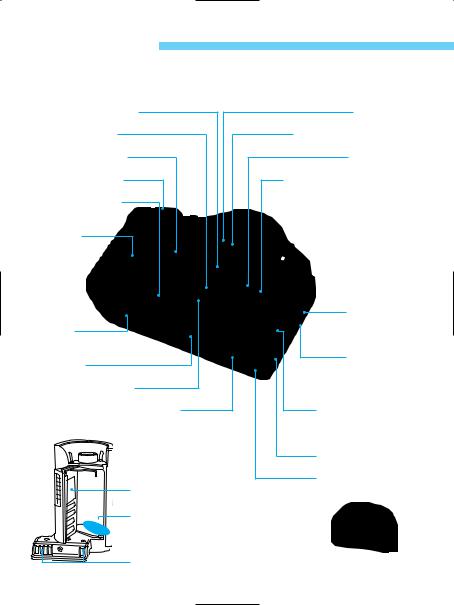
Nomenclature |
|
• Reference page numbers are indicated in parentheses. |
|
• In the text, camera controls are indicated by their respective icons. |
|
Focusing screen (→p.127) |
Lens mount |
Reflex mirror (→p.81) |
Lens mount index (→p.21) |
Self-timer lamp (→p.79) |
Lens lock pin |
Shutter button (→p.14) |
Lens release button (→p.21) |
Depth-of-field preview |
|
button (→p.80) |
|
Grip (Battery |
|
chamber) (→p.19) |
|
|
Camera back |
Grip screw |
lock release |
button (→p.25) |
|
(→p.19) |
|
Tripod socket |
Camera back |
lever (→p.25) |
|
Electrical contacts (→p.7) |
|
Power Drive Booster coupler (cover) |
Remote control/Data |
|
transfer terminal |
|
(N3 type) |
Grip |
PC terminal (→p.94) |
|
|
|
Power Drive Booster |
Battery cover |
coupling pin |
Battery contacts |
|
Electrical contacts |
Eyecup (→p.22) |
8
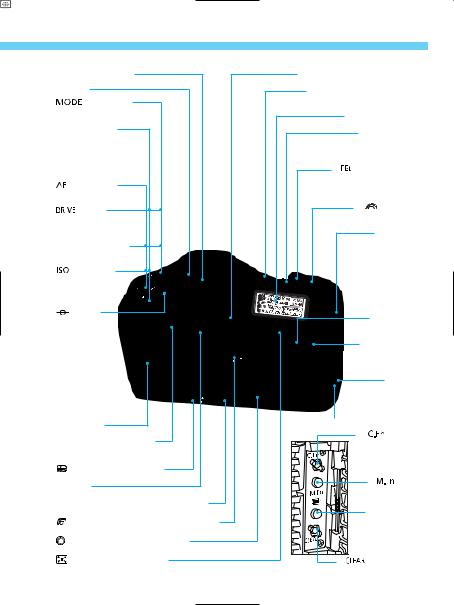
Nomenclature
Flash-sync contacts |
Eyepiece shutter lever (→p.80) |
Hot shoe |
|
< > LCD panel illumination |
|||
< |
> Shooting |
button (→p.82) |
|||
mode button (→p.30) |
LCD panel (→p.10) |
||||
< |
> Metering |
|
< |
> Exposure |
|
mode button / < |
> |
||||
compensation button / |
|||||
Flash exposure |
|
||||
|
Aperture button (→p.67/65) |
||||
compensation button |
< > FE lock button / |
||||
(→p.50 / 89) |
|
||||
< |
> AF mode |
|
Multi-spot metering button |
||
|
|
(→p.87/53) |
|||
button (→p.34) |
|
|
|||
|
< |
> Main Dial |
|||
< |
> Film |
|
|||
|
|
(→p.15) |
|||
advance mode |
|
|
|||
|
|
|
|||
button (→p.77) |
|
|
Strap eyelet |
||
< |
> AEB button |
|
|
(→p.13) |
|
(→p.69) |
|
|
|
||
< |
> ISO film |
|
|
|
|
speed button |
|
|
|
||
(→p.73) |
|
|
|
||
< |
> Film |
< > AE lock |
|
plane mark |
|||
button (→p.71) |
|||
|
|
||
|
|
< |
|
> Focusing |
||
|
|
|
point selector |
|||
|
|
|
|
|
(→p.38) |
|
|
|
|
|
Side door |
||
Film window |
Side Door Buttons |
|
|
|||
Dioptric adjustment knob |
< |
|
> Custom |
|||
|
|
Function set |
||||
(→p.22) |
|
|
||||
button (→p.96) |
||||||
|
|
|||||
< |
> Main switch (→p.14) |
|
|
|
|
|
Eyepiece |
|
< |
|
> Multi- |
||
Function button |
||||||
|
|
|||||
< |
> Midroll rewind button (→p.28) |
|
(→p.23, 112) |
|||
< > Quick Control Dial switch (→p.17) |
|
< |
> Multiple |
|||
|
|
exposure |
||||
< > Quick Control Dial (→p.17) |
button (→p.74) |
|||||
|
|
|
|
|||
< |
> Assist button (→p.42) |
< |
> Clear button |
|||
|
|
(→p.18, 97) |
9 |
|||
|
|
|
|
|
||
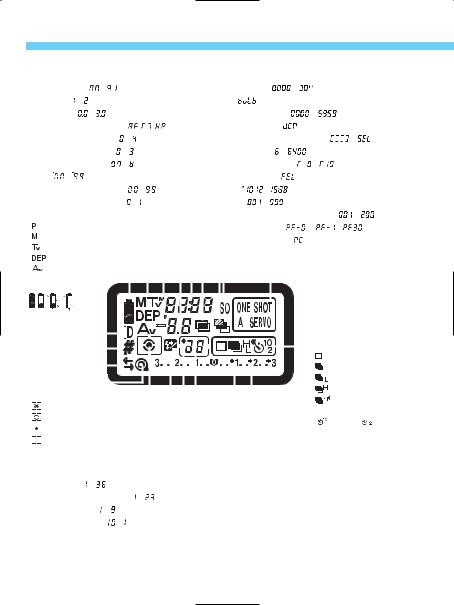
Nomenclature
LCD Panel
Aperture setting ( |
~ |
|
|
|
) |
|
|
|
|
|
|
|
|
|
|
|
|
|
|
|
|
|
|
|
|
|
|
|
Shutter speed ( |
~ |
) |
|
|
|
|||||||||||||||||||||||||
DEP points ( , |
) |
|
|
|
|
|
|
|
|
|
|
|
|
|
|
|
|
|
|
|
|
|
|
|
|
|
|
|
|
|
|
Bulb ( |
) |
|
|
|
|
|
|
|
|
|
|
||||||||||||||||
|
|
|
|
|
|
|
|
|
|
|
|
|
|
|
|
|
|
|
|
|
|
|
|
|
|
|
|
|
|
|
|
|
|
|
|
|
|
|
|||||||||||||||||||||
AEB amount ( |
~ |
|
|
) |
|
|
|
|
|
|
|
|
|
|
|
|
|
|
|
|
|
|
|
|
|
|
|
|
|
|
Bulb exposure time ( |
~ |
) |
|
|
||||||||||||||||||||||||
|
|
|
|
|
|
|
|
|
|
|
|
|
|
|
|
|
|
|
|
|
|
|
|
|
|
|
|||||||||||||||||||||||||||||||||
Focusing point selection mode ( |
|
, |
|
, ) |
|
|
|
|
|
|
|
|
|
|
|
|
|
|
Depth-of-field AE ( |
|
) |
|
|
|
|
||||||||||||||||||||||||||||||||||
|
|
|
|
|
|
|
|
|
|
|
|
|
|
|
|
|
|
|
|
||||||||||||||||||||||||||||||||||||||||
Custom Function setting ( |
~ |
) |
|
|
|
|
|
|
|
|
|
|
|
|
|
|
|
|
|
|
|
|
Focusing point selection mode ( |
|
, |
) |
|||||||||||||||||||||||||||||||||
|
|
|
|
|
|
|
|
|
|
|
|
|
|
|
|
|
|
|
|
|
|||||||||||||||||||||||||||||||||||||||
Custom Function group ( |
~ |
|
) |
|
|
|
|
|
|
|
|
|
|
|
|
|
|
|
|
|
|
|
|
ISO film speed ( |
~ |
) |
|
|
|
||||||||||||||||||||||||||||||
|
|
|
|
|
|
|
|
|
|
|
|
|
|
|
|
|
|
|
|
|
|
|
|
||||||||||||||||||||||||||||||||||||
ISO film speed stops ( |
~ |
|
) |
|
|
|
|
|
|
|
|
|
|
|
|
|
|
|
|
|
|
|
|
Custom Function No. ( |
~ |
) |
|
|
|||||||||||||||||||||||||||||||
|
|
|
|
|
|
|
|
|
|
|
|
|
|
|
|
|
|
|
|
|
|
|
|||||||||||||||||||||||||||||||||||||
Date* ( |
~ |
|
) |
|
|
|
|
|
|
|
|
|
|
|
|
|
|
|
|
|
|
|
|
|
|
|
|
|
|
|
|
|
|
|
|
FE lock indicator ( |
) |
|
|
|
|
|
|||||||||||||||||
|
|
|
|
|
|
|
|
|
|
|
|
|
|
|
|
|
|
|
|
|
|
|
|
|
|
|
|
|
|
|
|
|
|
|
|
||||||||||||||||||||||||
User-settable No. (Film ID) ( |
|
~ |
) |
|
|
|
|
|
|
|
|
|
|
|
|
|
|
|
Date* ( |
~ |
|
|
) |
|
|
|
|
|
|||||||||||||||||||||||||||||||
|
|
|
|
|
|
|
|
|
|
|
|
|
|
|
|
|
|
|
|
|
|
|
|||||||||||||||||||||||||||||||||||||
Personal Function setting* ( |
, |
) |
|
|
|
|
|
|
|
|
|
|
|
|
|
|
|
|
|
|
|
Film ID ( |
~ |
|
|
) |
|
|
|
|
|
||||||||||||||||||||||||||||
|
|
|
|
|
|
|
|
|
|
|
|
|
|
|
|
|
|
|
|
|
|
|
|
|
|
||||||||||||||||||||||||||||||||||
Shooting mode |
|
|
|
|
|
|
|
|
|
|
|
|
|
|
|
|
|
|
|
|
|
|
|
|
|
|
|
|
|
|
|
|
|
Remaining data-recordable rolls* ( |
~ |
) |
|||||||||||||||||||||||
: Program AE |
|
|
|
|
|
|
|
|
|
|
|
|
|
|
|
|
|
|
|
|
|
|
|
|
|
|
|
|
Personal Function ( |
) ( |
~ |
|
)* |
||||||||||||||||||||||||||
|
|
|
|
|
|
|
|
|
|
|
|
|
|
|
|
|
|
|
|
|
|
|
|
|
|
|
|
|
|||||||||||||||||||||||||||||||
: Manual exposure mode |
|
|
|
|
|
|
|
|
|
|
|
|
|
|
|
|
|
|
|
Data transfer mode* ( |
) |
|
|
|
|
||||||||||||||||||||||||||||||||||
: Shutter speed-priority AE mode |
|
|
|
|
|
|
|
|
|
|
|
|
|
|
|
|
|
|
|
|
|
|
|
||||||||||||||||||||||||||||||||||||
Month* |
|
|
|
|
|
|
|
|
|
|
Multiple exposures |
|
|
|
|
|
|||||||||||||||||||||||||||||||||||||||||||
: Depth-of-field AE mode |
|
|
|
|
|
|
|
|
|
|
|
|
|
|
|
|
|
|
|
|
|
|
|
|
|
AEB |
|
|
|
|
|
|
|
|
|
AF mode |
|
|
|||||||||||||||||||||
: Aperture-priority AE mode |
|
|
|
|
|
|
|
|
|
|
|
|
|
|
|
|
|
|
|
|
|
|
|
|
|
|
|
|
|
|
|
|
|
|
|
|
|||||||||||||||||||||||
|
|
|
|
|
|
|
|
|
|
|
|
|
|
|
|
|
|
|
|
|
|
|
|
|
ISO icon |
|
|
|
|
One-Shot AF |
|
||||||||||||||||||||||||||||
Battery level icon |
|
|
|
|
|
|
|
|
|
|
|
|
|
|
|
|
|
|
|
|
|
|
|
|
|
|
|
|
|
|
|
|
|
|
|
|
|
|
|
|
|
|
|||||||||||||||||
|
|
|
|
|
|
|
|
|
|
|
|
|
|
|
|
|
|
|
|
|
|
|
|
|
|
|
|
|
|
|
|
|
|
|
|
|
|
|
|
|
|
|
|
|
|
|
|
|
|
|
|
AI Servo AF |
|
||||||
ID icon |
|
|
|
|
|
|
|
|
|
|
|
|
|
|
|
|
|
|
|
|
|
|
|
|
|
|
|
|
|
|
|
|
|
|
|
|
|
|
|
|
|
|
|
|
|
|
|
|
|
|
|
|
|
|
|
Film advance mode |
|||
|
|
|
|
|
|
|
|
|
|
|
|
|
|
|
|
|
|
|
|
|
|
|
|
|
|
|
|
|
|
|
|
|
|
|
|
|
|
|
|
|
|
|
|
|
|
|
|
|
|
|
|
|
|
|
|||||
|
|
|
|
|
|
|
|
|
|
|
|
|
|
|
|
|
|
|
|
|
|
|
|
|
|
|
|
|
|
|
|
|
|
|
|
|
|
|
|
|
|
|
|
|
|
|
|
|
|
|
|
|
|
|
|||||
|
|
|
|
|
|
|
|
|
|
|
|
|
|
|
|
|
|
|
|
|
|
|
|
|
|
|
|
|
|
|
|
|
|
|
|
|
|
|
|
|
|
|
|
|
|
|
|
|
|
|
|
|
|
|
|||||
|
|
|
|
|
|
|
|
|
|
|
|
|
|
|
|
|
|
|
|
|
|
|
|
|
|
|
|
|
|
|
|
|
|
|
|
|
|
|
|
|
|
|
|
|
|
|
|
|
|
|
|
|
|
|
|||||
PF icon |
|
|
|
|
|
|
|
|
|
|
|
|
|
|
|
|
|
|
|
|
|
|
|
|
|
|
|
|
|
|
|
|
|
|
|
|
|
|
|
|
|
|
|
|
|
|
|
|
|
|
|
|
|
|
|
||||
Data transfer icon* |
|
|
|
|
|
|
|
|
|
|
|
|
|
|
|
|
|
|
|
|
|
|
|
|
|
|
|
|
|
|
|
|
|
|
|
|
|
|
|
|
|
|
|
|
|
|
|
|
|
|
|
Single-frame |
|||||||
|
|
|
|
|
|
|
|
|
|
|
|
|
|
|
|
|
|
|
|
|
|
|
|
|
|
|
|
|
|
|
|
|
|
|
|
|
|
|
|
|
|
|
|
|
|
|
|
|
|
|
Continuous |
||||||||
Film-loaded indicator |
|
|
|
|
|
|
|
|
|
|
|
|
|
|
|
|
|
|
|
|
|
|
|
|
|
|
|
|
|
|
|
|
|
|
|
|
|
|
|
|
|
|
|
|
|
|
|
|
|
Low-speed continuous |
|||||||||
|
|
|
|
|
|
|
|
|
|
|
|
|
|
|
|
|
|
|
|
|
|
|
|
|
|
|
|
|
|
|
|
|
|
|
|
|
|
|
|
|
|
|
|
|
|
|
|
|
|||||||||||
|
|
|
|
|
|
|
|
|
|
|
|
|
|
|
|
|
|
|
|
|
|
|
|
|
|
|
|
|
|
|
|
|
|
|
|
|
|
|
|
|
|
|
|
|
|
|
|
|
High-speed continuous |
||||||||||
Metering mode |
|
|
|
|
|
|
|
|
|
|
|
|
|
|
|
|
|
|
|
|
|
|
|
|
|
|
|
|
|
|
|
|
|
|
|
|
|
|
|
|
|
|
|
|
|
|
|
|
|
|
|
|
|
|
|
||||
|
|
|
|
|
|
|
|
|
|
|
|
|
|
|
|
|
|
|
|
|
|
|
|
|
|
|
|
|
|
|
|
|
|
|
|
|
|
|
|
|
|
|
|
|
|
|
|
|
|
|
|
|
|
|
Ultra-high speed continuous |
||||
Evaluative metering |
|
|
|
|
|
|
|
|
|
|
|
|
|
|
|
|
|
|
|
|
|
|
|
|
|
|
|
|
|
|
|
|
|
|
|
|
|
|
|
|
|
|
|
|
|
||||||||||||||
|
|
|
|
|
|
|
|
|
|
|
|
|
|
|
|
|
|
|
|
|
|
|
|
|
|
|
|
|
|
|
|
|
|
|
|
|
|
|
|
|
|
|
|
Self-timer |
|
|
|||||||||||||
Partial metering |
|
|
|
|
|
|
|
|
|
|
|
|
|
|
|
|
|
|
|
|
|
|
|
|
|
|
|
|
|
|
|
|
|
|
|
|
|
|
|
|
|
|
|
|
|
|
|
|
|
|
|||||||||
|
|
|
|
|
|
|
|
|
|
|
|
|
|
|
|
|
|
|
|
|
|
|
|
|
|
|
|
|
|
|
|
|
|
|
|
|
|
|
|
|
|
|
|
|
|
|
|
|
|
||||||||||
|
|
|
|
|
|
|
|
|
|
|
|
|
|
|
|
|
|
|
|
|
|
|
|
|
|
|
|
|
|
|
|
|
|
|
|
|
|
|
|
|
|
|
|
|
|
|
( |
10 sec., |
2 sec.) |
||||||||||
Spot metering |
|
|
|
|
|
|
|
|
|
|
|
|
|
|
|
|
|
|
|
|
|
|
|
|
|
|
|
|
|
|
|
|
|
|
|
|
|
|
|
|
|
|
|
|
|
|
|
||||||||||||
|
|
|
|
|
|
|
|
|
|
|
|
|
|
|
|
|
|
|
|
|
|
|
|
|
|
|
|
|
|
|
|
|
|
|
|
|
|
|
|
|
|
|
|
|
|
|
|
|
|
|
|
||||||||
Center-weighted averaging metering |
|
|
|
|
|
|
|
|
|
|
|
|
|
|
|
|
|
|
|
|
|
|
|
Exposure level scale |
|
|
|||||||||||||||||||||||||||||||||
|
|
|
|
|
|
|
|
|
|
|
|
|
|
|
|
|
|
|
|
|
|
|
|
|
|
|
|
|
|
|
|
|
|
|
|
|
|
|
|
|
|
|
|
|
|
|
|
|
|
|
|||||||||
Flash exposure compensation |
|
|
|
|
|
|
|
|
|
|
|
|
|
|
|
|
|
|
|
|
|
|
|
|
|
|
|
|
|
|
|
|
|
|
Exposure amount |
|
|
|
|||||||||||||||||||||
|
|
|
|
|
|
|
|
|
|
|
|
|
|
|
|
|
|
|
|
|
|
|
|
|
|
|
|
|
|
|
|
|
|
|
|
|
|||||||||||||||||||||||
Frame countdown icon |
|
|
|
|
|
|
|
|
|
|
|
|
|
|
|
|
|
|
|
|
|
|
|
|
|
|
|
|
|
|
|
|
|
|
|
|
|
|
|
|
AEB amount |
|
|
|
|||||||||||||||
|
|
|
|
|
|
|
|
|
|
|
|
|
|
|
|
|
|
|
|
|
|
|
|
|
|
|
|
|
|
|
|
|
|
|
|
|
|
|
|
|
|
|
|||||||||||||||||
Frame counter ( |
~ |
|
|
) |
|
|
|
|
|
|
|
|
|
|
|
|
|
|
|
|
|
|
|
|
|
|
|
|
|
|
|
|
|
|
|
|
|
|
|
|
|
|
|
Flash exposure compensation amount |
|||||||||||||||
|
|
|
|
|
|
|
|
|
|
|
|
|
|
|
|
|
|
|
|
|
|
|
|
|
|
|
|
|
|
|
|
|
|
|
|
|
|
|
|||||||||||||||||||||
Bulb exposure time indicator ( |
~ |
|
|
|
|
) (hours) |
|
|
|
|
|
|
|
|
|
|
|
|
|
|
|
|
|
|
|
|
|
Film transport indicator |
|
|
|||||||||||||||||||||||||||||
|
|
|
|
|
|
|
|
|
|
|
|
|
|
|
|
|
|
|
|
|
|
|
|
|
|
||||||||||||||||||||||||||||||||||
Multiple exposures ( |
~ |
|
|
|
) |
|
|
|
|
|
|
|
|
|
|
|
|
|
|
|
|
|
|
|
|
|
|
|
|
|
|
|
|
|
|
|
|
|
|
|
|
Custom Function setting indicator |
|||||||||||||||||
|
|
|
|
|
|
|
|
|
|
|
|
|
|
|
|
|
|
|
|
|
|
|
|
|
|
|
|
|
|
|
|
|
|
|
|
|
|
|
|||||||||||||||||||||
Self-timer countdown ( |
~ |
|
) |
|
|
|
|
|
|
|
|
|
|
|
|
|
|
|
|
|
|
|
|
|
|
|
|
|
|
|
|
|
|
|
|
|
|
Remaining data-recordable rolls* (5-roll units) |
|||||||||||||||||||||
|
|
|
|
|
|
|
|
|
|
|
|
|
|
|
|
|
|
|
|
|
|
|
|
|
|
|
|
|
|
|
|
|
|
|
|||||||||||||||||||||||||
•The LCD panel has color-coded display boxes which contain icons or indications of related camera settings.
•Asterisked items are related to the EOS LINK SOFTWARE ES-E1 (sold separately).
10
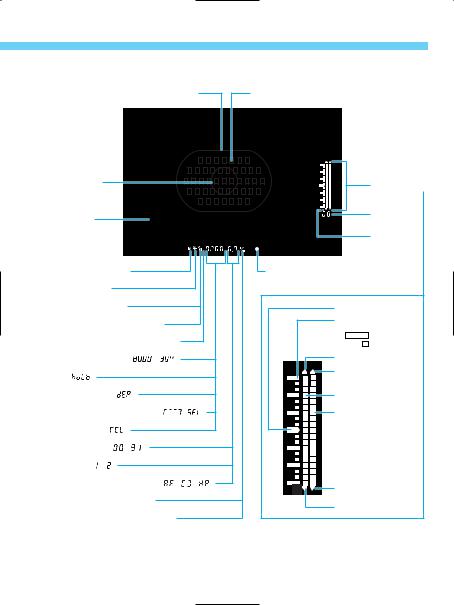
Nomenclature
|
|
|
|
Viewfinder Information |
|
||
|
|
|
Area AF ellipse |
Focusing points |
|
||
Spot metering |
|
|
|
|
|
Exposure level |
|
circle |
|
|
|
|
|
|
|
|
|
|
|
|
|
indicator |
|
|
|
|
|
|
|
|
|
Laser-matte |
|
|
|
|
|
Frame |
|
|
|
|
|
|
counter |
||
screen |
|
|
|
|
|
|
|
|
|
|
|
|
|
Frame |
|
|
|
|
|
|
|
|
|
|
|
|
|
|
|
|
countdown |
|
|
|
|
|
|
|
icon |
Manual exposure icon |
|
|
|
In-focus indicator |
|
||
AE lock indicator |
|
|
|
|
|
|
|
Flash-ready indicator |
|
|
|
|
Correct exposure index |
||
FE lock underexposure warning |
|
|
|
Exposure level |
|||
|
|
|
increments |
||||
|
|
|
|
|
|
|
|
High-speed sync indicator (FP flash) |
|
|
: 1 stop |
||||
|
|
: 1/3 stop |
|||||
Shutter speed display ( |
~ |
) |
|
|
Overexposure indicator |
||
Bulb ( |
) |
|
|
|
|
|
Flash overexposure |
|
|
|
|
|
indicator |
||
Depth-of-field AE ( |
) |
|
|
|
Exposure level indicator |
||
Focusing point selection mode ( |
, |
) |
|
Flash exposure level |
|||
|
|
|
|
|
|
|
indicator |
FE lock display ( |
) |
|
|
|
|
|
|
Aperture display ( |
~ |
) |
|
|
|
|
|
DEP points ( , |
) |
|
|
|
|
|
|
Focusing point selection mode ( |
, |
, |
) |
Flash underexposure |
|||
|
|
|
|
|
|
|
|
Exposure compensation icon |
|
|
|
indicator |
|||
|
|
|
Underexposure indicator |
||||
|
|
|
|
|
|
|
|
Flash exposure compensation icon |
|
|
|
||||
On pages 10 and 11, the LCD panel and viewfinder are shown with all the icons and indications displayed. The items actually displayed differ depending on the camera settings.
11
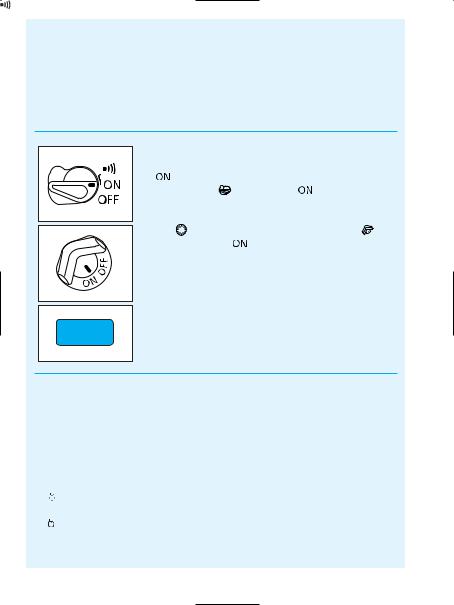
Conventions Used in this Instruction Booklet
•In this booklet, the <  > icon indicates the Main Dial, <
> icon indicates the Main Dial, <  > is the Quick Control Dial, <
> is the Quick Control Dial, <  > is the main switch, and <
> is the main switch, and <  > is the Quick Control Dial switch.
> is the Quick Control Dial switch.
•All the operations described in this booklet assume that the <  > switch is already set to
> switch is already set to
|
< >. Before proceeding with any operation, |
|
|
first turn the < |
> switch to < > or < >. |
|
• For < > dial operations, make sure the < > |
|
|
switch is set to < |
>. |
|
• This symbol is used to indicate that there is a |
|
C.Fn |
related Custom Function. |
|
For details, see “Custom Functions” on page 95. |
||
•The camera control icons and markings used in this booklet correspond to the actual icons and markings found on the camera.
See "Nomenclature" on page 8. Reference page numbers are also stated in parentheses (→p.■)
•In this instruction booklet, a Canon EF 50mm f/1.4 USM lens is used for explaining the procedures.
•The procedures are based on the assumption that the Custom Functions are set to the default settings.
•(  6 ) indicates that the function described remains in effect for 6 sec. after the shutter button is released.
6 ) indicates that the function described remains in effect for 6 sec. after the shutter button is released.
•(  16 ) indicates that the function described remains in effect for 16 sec. after the shutter button is released.
16 ) indicates that the function described remains in effect for 16 sec. after the shutter button is released.
12

13
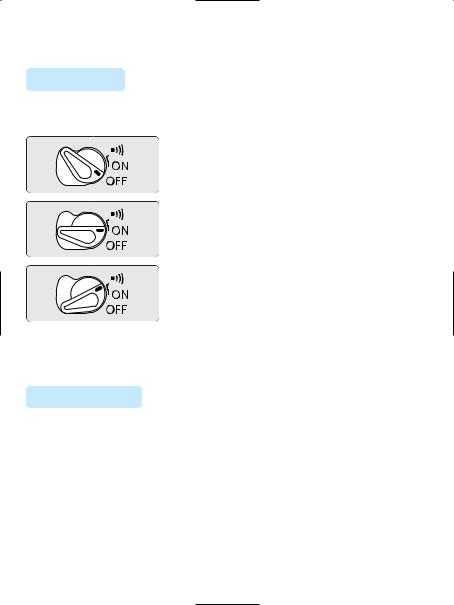
Basic Operation 
Main Switch
The camera operates only after the <  > switch is turned on. This switch has three settings:
> switch is turned on. This switch has three settings:
< 
 > : The camera does not operate. Set to this position when not using the camera.
> : The camera does not operate. Set to this position when not using the camera.
<  > : To turn on the camera, set to this position.
> : To turn on the camera, set to this position.
<  > : This is the same as <
> : This is the same as <  > except that it also enables the beeper to sound in the following cases:
> except that it also enables the beeper to sound in the following cases:
• Focus is achieved in One-Shot AF mode.
•Focus is achieved with manual focus.
Shutter Button
You can press the shutter button halfway or all the way.
Hold the camera steadily and press the shutter button slowly without any jerking movement. The difference between halfway and complete pressing of the shutter button is explained below. Beginners should practice pressing the shutter button halfway and completely before loading any film.
14
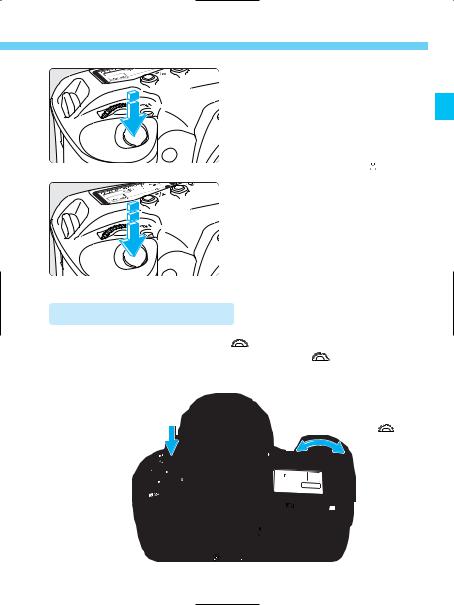
Basic Operation
Halfway pressing
When the shutter button is pressed halfway, autofocusing (AF) is activated to focus the subject. Autoexposure (AE) metering is also turned on to set the correct shutter speed and aperture which are displayed in the viewfinder and on the LCD panel for (  6 ).
6 ).
Complete pressing
This releases the shutter and takes the picture. After the frame is exposed, the camera advances the film automatically.
Using the Electronic Dials
There are three ways to use the < |
> dial: |
|
|
1. Press and hold down a button and then turn the < |
> dial while looking |
||
at the LCD panel. When the button is released, you can take a picture. |
|||
1 Hold down a button... |
2 then turn the < |
>. |
|
|
|||
15
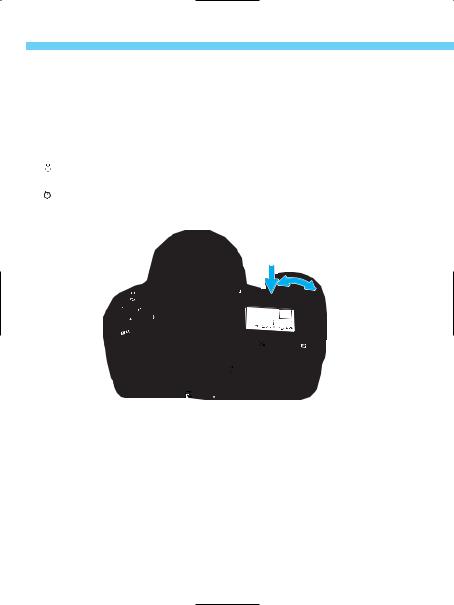
Basic Operation
2.After pressing a button, turn the <  > dial.
> dial.
When a button is pressed, its function remains active for 6 or 16 seconds. You then look at the LCD panel and turn the <  > dial during
> dial during
this time. After the function turns off or when you press the shutter button halfway again, the camera will be ready to take a picture.
Buttons which turn on for 6 or 16 seconds are indicated in this instruction booklet with the following icons:
(  6 ) : The button's function remains active for 6 seconds after the button is released.
6 ) : The button's function remains active for 6 seconds after the button is released.
(  16 ) : The button's function remains active for 16 seconds after the button is released.
16 ) : The button's function remains active for 16 seconds after the button is released.
1 After a button is pressed...
2 turn the <  >.
>.
3.Just turn the <  > dial.
> dial.
While looking at the LCD panel, you can set the shutter speed, aperture, or another setting.
16
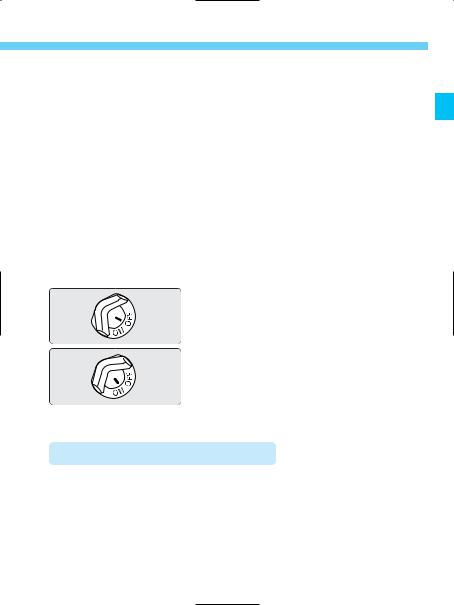
Basic Operation
There are three ways to use the <  >:
>:
1.While holding down a button, turn the <  > dial.
> dial.
2.After pressing and releasing a button, turn the <  > dial.
> dial.
3.Just turn the <  > dial.
> dial.
Look at the LCD panel to confirm the setting.
To restore the button's function or to ready the camera for picture taking, turn the <  > dial.
> dial.
The < > is used to set the following:
> is used to set the following:
1.Real-time exposure compensation
2.Aperture
3.Flash exposure compensation
4.Focusing point selection
The < > dial functions only when the <
> dial functions only when the <  > switch is set to <
> switch is set to < >.
>.
<
 > : Set to this position to disable the
> : Set to this position to disable the
< >.
>.
< > : Set to this position to enable the
> : Set to this position to enable the
< >.
>.
Reverting to the Default Settings
With the EOS-1V, you can set the shooting mode, metering mode, and other settings as you wish. You can also use Custom Functions (→p.95) to customize camera controls and functions according to your preferences. These preferences can be reset to the default settings with the following procedure.
17
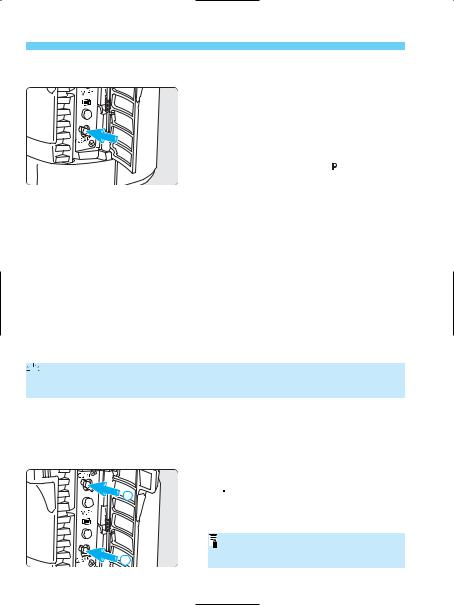
Basic Operation
Resetting the camera to the default settings
Open the side door and press the <

 > button.
> button.
 This will reset the camera to the default settings shown in the table below.
This will reset the camera to the default settings shown in the table below.
Shooting mode |
< > Program AE |
AF mode |
One-Shot AF |
|
|
Metering mode |
Evaluative |
Film advance mode |
Single |
|
|
Focusing point selection |
Automatic |
Multiple exposures |
Canceled |
|
|
Exposure compensation |
0 |
Flash exposure compensation |
0 |
|
|
AE lock |
Canceled |
FE lock |
Canceled |
|
|
AEB |
Canceled |
Custom Functions |
Settings retained |
|
|
Focusing point registration |
Center focusing point |
|
|


 When the camera is reset, the shooting mode will be set automatically to <
When the camera is reset, the shooting mode will be set automatically to <  > Program AE (→p.29).
> Program AE (→p.29).
Resetting all Custom Functions except C.Fn-0 (→p.98) to the default settings
1
2
Open the side door, press the
<
 > button, then press the
> button, then press the
<

 > button.
> button.
“C.Fn” is the abbreviation for “Custom Function.”
18
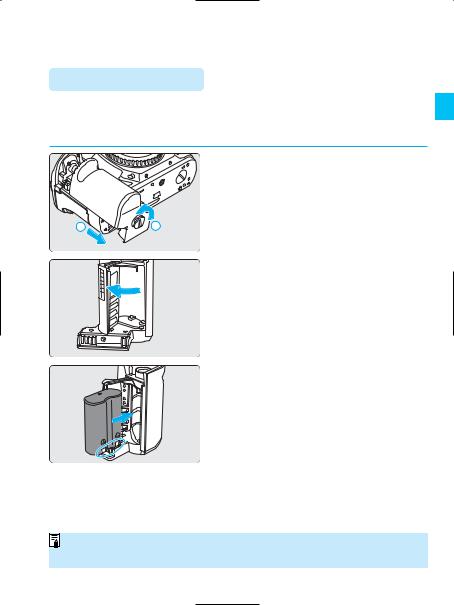
Installing the Battery and Checking the Battery Level 
Installing the Battery
The battery is housed in the camera grip. Remove the grip to install one
2CR5 lithium battery.
• For the EOS-1V HS, see page 115.
1 Remove the grip.
• Use a coin to turn and loosen the grip screw as shown by the arrow in the figure. Slide off the grip downward.
2 |
1 |
2Open the cover.
3Install the battery.
• Install the battery so that the battery contacts are on the right and bottom. Then close the cover.
Reattach the grip.
4• Reattach the grip to the camera, then turn the grip screw to tighten securely.
Lithium batteries may not be available in certain areas. Carry a spare battery when going on a trip or when you will use many rolls of film.
19
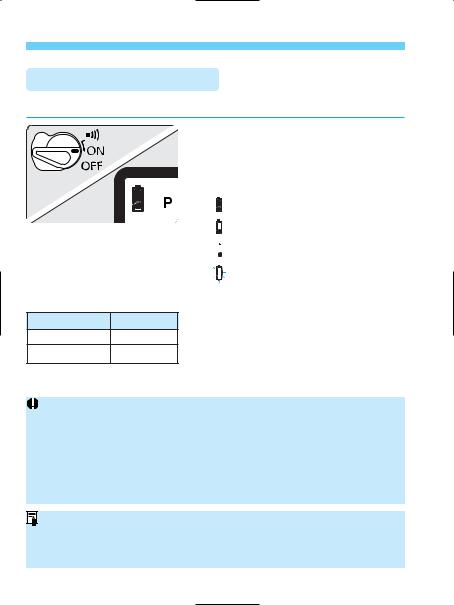
Installing the Battery and Checking the Battery Level
Checking the Battery Level
Check the battery level after replacing the batteries or before using the camera.
Battery Life (No. of Rolls)
Temperature |
Rolls |
At 20˚C |
75 (50) |
At –20˚C |
18 (12) |
Turn the < > to <
> to < >.
>.
 The battery level will be checked automatically and the LCD panel will then display one of the following battery level icons:
The battery level will be checked automatically and the LCD panel will then display one of the following battery level icons:
: Battery level OK.
: Keep spare battery handy.
 : Battery will soon be exhausted.
: Battery will soon be exhausted.
: Replace with new battery. (→p.7)
•The table shows the number of 24-exposure rolls based on Canon’s tests with a new battery and an EF 50mm f/1.4 USM lens. Figures in parentheses are the number of 36-exposure rolls.
•Information on battery life with Power Drive Booster PB-E2 or E1 and Battery Pack BP-E1 is provided in the respective instruction booklet.
•If the <  > is set to <
> is set to <  > and nothing is displayed on the LCD panel, the battery may have been installed incorrectly. Take out the battery and install correctly. Then check the battery level again.
> and nothing is displayed on the LCD panel, the battery may have been installed incorrectly. Take out the battery and install correctly. Then check the battery level again.
•Since actual shooting conditions may differ, the actual number of rolls may be less than the figures in the table.
•Pressing the shutter button halfway for prolonged periods or frequent autofocusing without taking any pictures will lower the number of rolls that can be taken.
•When the camera is not to be used, set the <  > to <
> to < 
 >. This will prevent accidental battery drainage if the shutter button is held down inadvertently.
>. This will prevent accidental battery drainage if the shutter button is held down inadvertently.
•The battery level is indicated each time the <  > is turned on. To check the current battery level, turn on the <
> is turned on. To check the current battery level, turn on the <  > again.
> again.
20
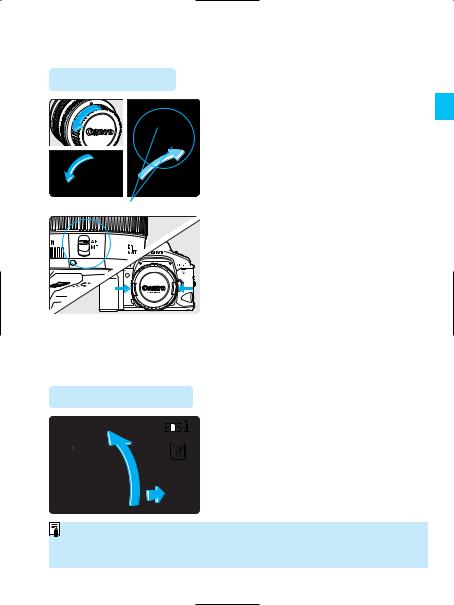
Mounting and Detaching a Lens 
Mounting a Lens
Red dots

 1
1
2Attach the lens.
• Align the red dots on the lens and camera and turn the lens as shown by the arrow until it snaps in place.
3
4Remove the front lens cap.
Detaching the Lens
2 |
While pressing the lens release |
|
button, turn the lens as shown by |
||
|
||
|
the arrow. |
|
|
• Turn the lens until it stops, then |
|
|
remove the lens. |
|
|
1 |
• Be careful not to lose the lens caps and body cap.
•AF stands for autofocus.
•MF or M stands for manual focus.
21
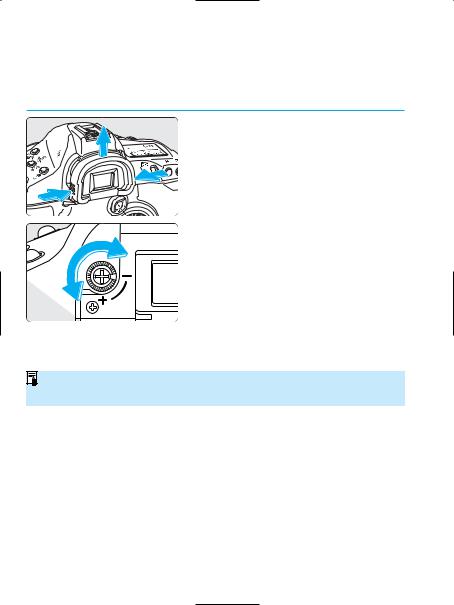
Dioptric Adjustment 
By adjusting the diopter to suit your vision (with or without eyeglasses), the viewfinder image will look clearer. The camera’s adjustable dioptric range is –3 to +1 dpt.
1 Remove the eyecup.
• While grasping both sides of the eyecup, slide it upward to remove.
 2Turn the dioptric adjustment knob.
2Turn the dioptric adjustment knob.
• Turn the knob to the right or left until the focusing point or the center spot metering circle looks sharp in the viewfinder.
• The diagram shows the knob set at the standard diopter (–1 dpt).
3Reattach the eyecup.
If the viewfinder still does not look sharp after you turn the dioptric adjustment knob, use one of the E-series dioptric adjustment lenses (sold separately). (→p.132)
Film ID Imprinting 
A film ID No. consisting of a user-settable number (two digits) and a film roll No. (three digits) is imprinted automatically on the film leader. The usersettable number can be used to identify which EOS-1V body you used (if you have multiple EOS-1V bodies) to shoot that roll. The film roll No. counts up each time you load a roll of film into the camera. This way, you can check the order in which the rolls were exposed.
The film ID is also used to match the shooting data recorded by the camera. The shooting data is transferred to a personal computer with the EOS LINK SOFTWARE ES-E1 (sold separately).
22
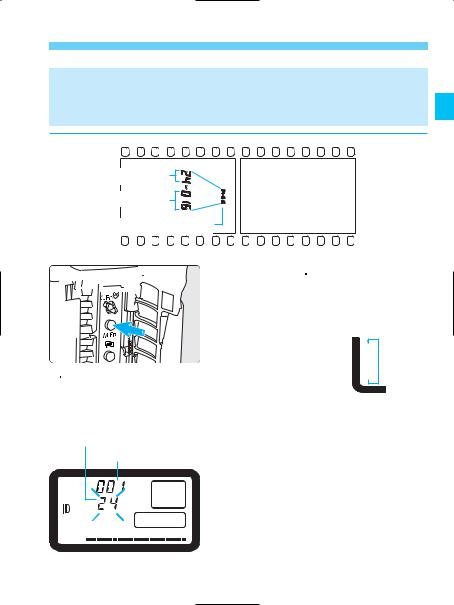
Film ID Imprinting
 Be sure to set the user-settable No. before loading the film. The film ID is imprinted automatically as it advances to frame 1 after loading. You cannot set the user-settable No. once the film has been loaded. You also cannot set the film roll No.
Be sure to set the user-settable No. before loading the film. The film ID is imprinted automatically as it advances to frame 1 after loading. You cannot set the user-settable No. once the film has been loaded. You also cannot set the film roll No.
User-settable No. |
|
Film roll No. |
Frame 1 |
Imprinting position |
|

 1
1

 : Multi Function. This refers to the EOS-1V’s extended functions.
: Multi Function. This refers to the EOS-1V’s extended functions.
User-settable No.
Film roll No.
Press the <
 > button to set the film ID setting mode.
> button to set the film ID setting mode.
•Each time you press the button, the following icons will be displayed in turn on the left side of the LCD panel. Display the  icon.
icon.
ID icon 


PF icon 

Data transfer icon 

 The blinking number is the usersettable No.
The blinking number is the usersettable No.
•After the film advances to frame 1, the user-settable No. will be displayed and it cannot be changed.
2Turn the <  > dial to set the desired user-settable No.
> dial to set the desired user-settable No.
•You can set any number from 

 to
to

 .
.
•The film roll No. is set sequentially from 

 to
to 

 . After
. After 

 , it will start from
, it will start from 

 again.
again.
23
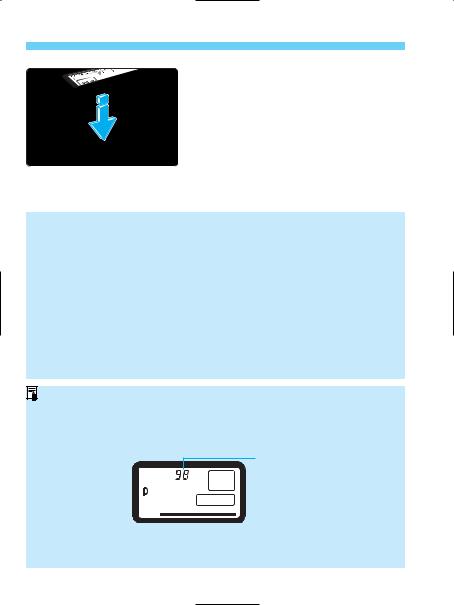
Film ID Imprinting




 3
3
Press the shutter button halfway.
 The LCD panel will return to the normal display and the user-settable No. will be set.
The LCD panel will return to the normal display and the user-settable No. will be set.
When the film is loaded, the ID icon will be displayed on the LCD
 • In low temperatures (–10˚C), the liquid crystal used for imprinting the film ID will have a slower response. Therefore, it may take a few seconds for the imprinting to be completed. To ensure proper film ID imprinting, do not start taking pictures until the ID icon on the LCD panel turns off. If you take a picture during film ID imprinting, the imprinting will be canceled and the picture will be taken.
• In low temperatures (–10˚C), the liquid crystal used for imprinting the film ID will have a slower response. Therefore, it may take a few seconds for the imprinting to be completed. To ensure proper film ID imprinting, do not start taking pictures until the ID icon on the LCD panel turns off. If you take a picture during film ID imprinting, the imprinting will be canceled and the picture will be taken.
•Film ID imprinting is assured between 45˚C and –10˚C. In colder temperatures, the response of the liquid crystal will be extremely slow and the film ID might fail to be imprinted.
•If a roll of film is rewound in midroll and later loaded into the camera again, the film ID will be imprinted over the previous film ID.
•Depending on your photofinisher, the film leader where the film ID is imprinted might not come back with your processed film. When submitting the film for processing, be sure to mention that you want the film leader returned as well.
• The film ID imprinting cannot be turned off.
•When you press the <  > button in step 2 on the preceding page, the number of remaining rolls whose shooting data can be stored in the camera’s memory will be displayed. This number is used when you use the EOS LINK SOFTWARE ES-E1 (sold separately).
> button in step 2 on the preceding page, the number of remaining rolls whose shooting data can be stored in the camera’s memory will be displayed. This number is used when you use the EOS LINK SOFTWARE ES-E1 (sold separately).
Remaining 36-ex. rolls whose shooting data can be recorded
 Indicator of remaining rolls (each bar represents 5 rolls)
Indicator of remaining rolls (each bar represents 5 rolls)
•If Dateback DB-E2 (sold separately) is used instead of the standard camera back, there will be no film ID imprinting.
24
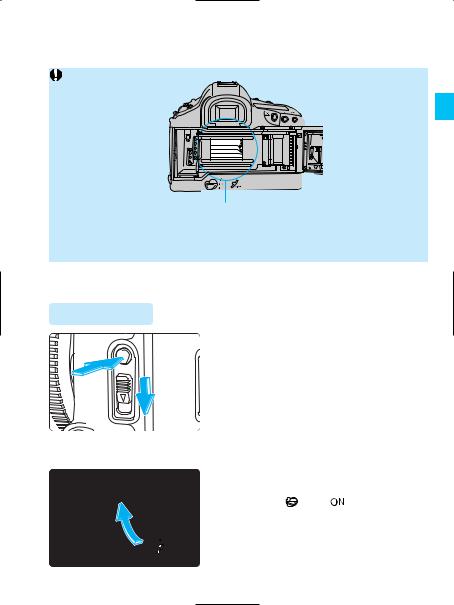
Loading and Unloading Film 
Shutter curtain
The shutter curtains have been manufactured at very high precision. Never touch them with your fingers. When loading film, do not touch or damage the curtains with your fingers or film.
Loading Film
1
1 Open the camera back.
• Use your thumb to press the camera back lock release button and slide
2the camera back lever down as shown by the arrow to open the camera back.
•If this is difficult to do with one finger, use one finger to press the lock release button and another finger to slide down the lever.
2 |
Insert the film cartridge at an |
angle as shown in the figure. |
|
• Set the < > to < >. |
25

Loading and Unloading Film
Right 3
Orange mark
Pull the edge of the film leader to the orange mark on the camera.
•Hold down the film cartridge while pulling out the film leader.
•If the edge of the film leader goes beyond the orange mark, rewind some of the film back into the cartridge.
Wrong

 4Close the camera back.
4Close the camera back.
• After checking that the film leader
edge is correctly aligned with the
orange mark, close the camera back.
 The film will advance to frame 1
The film will advance to frame 1
automatically.
 After the film ID is imprinted, the cartridge icon and frame counter “
After the film ID is imprinted, the cartridge icon and frame counter “  ” will be displayed.
” will be displayed.
Film ID being imprinted
26
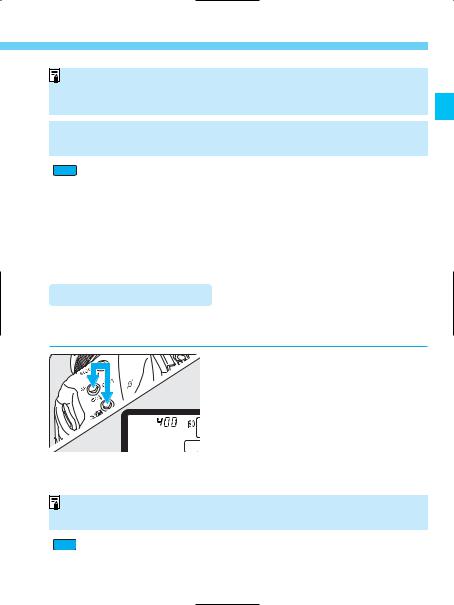
Loading and Unloading Film
• If the film is not loaded properly, the film transport indicator < 

 > will blink and the shutter will not work. Reload the film properly.
> will blink and the shutter will not work. Reload the film properly.
• Infrared film can also be used. (→p.82)
 In hot and humid environments, do not remove the film packaging until you are ready to load the film.
In hot and humid environments, do not remove the film packaging until you are ready to load the film.
C.Fn The frame counter can either count up or count down. (C.Fn-8-1→p.103)
Setting the Film Speed
The camera sets the film speed automatically within ISO 25 - 5000 with the film's DX code.
Press the <  > and <
> and <  > buttons simultaneously.
> buttons simultaneously.
 The LCD panel will display the
The LCD panel will display the 
 icon and the film speed.
icon and the film speed.
If the film speed displayed does not match the film speed or if the film is not DXcoded, see “Setting the Film Speed Manually” on page 73.
C.Fn C.Fn 3 can prevent the ISO film speed from being set automatically with the DX code. (→p.99)
27
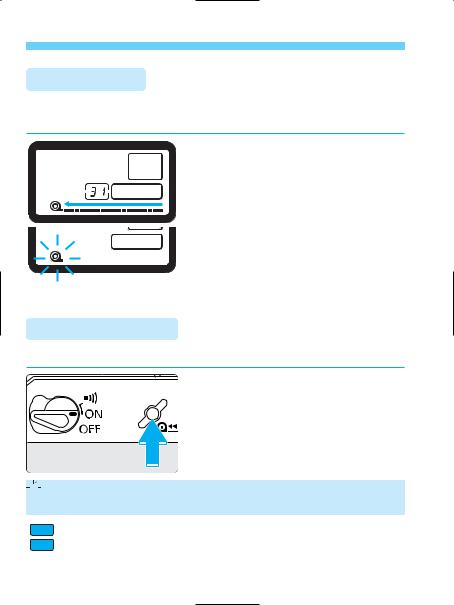
Loading and Unloading Film
Unloading Film
After the film's last frame is exposed, the camera rewinds the film automatically.
 When the film starts to rewind, the film advance and rewind indicator on the LCD panel will “flow” from right to left to indicate that the film is rewinding. The frame counter also counts in reverse.
When the film starts to rewind, the film advance and rewind indicator on the LCD panel will “flow” from right to left to indicate that the film is rewinding. The frame counter also counts in reverse.
 The film rewind ends automatically. Check that the <
The film rewind ends automatically. Check that the <  > icon on the LCD panel is blinking, then remove the film cartridge.
> icon on the LCD panel is blinking, then remove the film cartridge.

 Midroll Rewind
Midroll Rewind
To rewind the film in midroll, follow the procedure below.
1 Press the <  > button.
> button.
 The film will start rewinding. The subsequent operation will then be the same as normal film rewind.
The film will start rewinding. The subsequent operation will then be the same as normal film rewind.
2Take out the film cartridge.


 During film rewind, pressing the <
During film rewind, pressing the <  > button also toggles between highspeed and low-speed (quiet) rewind.
> button also toggles between highspeed and low-speed (quiet) rewind.
C.Fn Custom Function C.Fn-1 can alter the rewind speed and method. (→p.98)
C.Fn Normally, the entire film leader is rewound inside the film cartridge. Custom Function C.Fn-2 can leave out the film leader after film rewind. (→p.99)
28
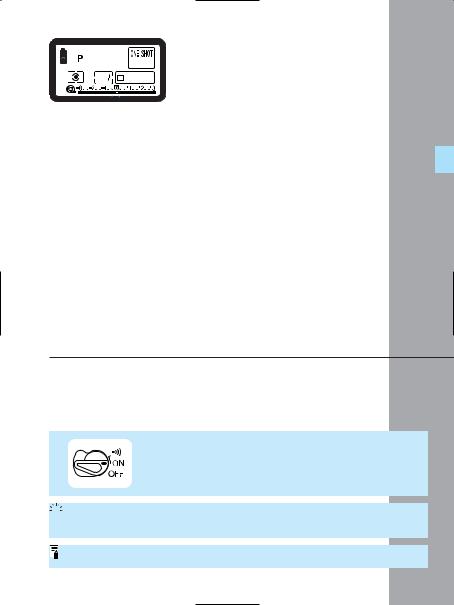
For quick and easy picture-taking, use the Program AE mode. This mode sets both the shutter speed and aperture automatically to suit the subject's brightness. Anyone can easily take pictures in this mode. By using the large Area AF ellipse in the viewfinder, it is easy to frame and capture a variety of subjects.
2Quick Start With
Program AE
First set the <  > switch to <
> switch to <  >.
>.


 The Program AE mode is set automatically as the camera's initial shooting mode. (→p.17)
The Program AE mode is set automatically as the camera's initial shooting mode. (→p.17)
AE is an abbreviation for Auto Exposure.
29
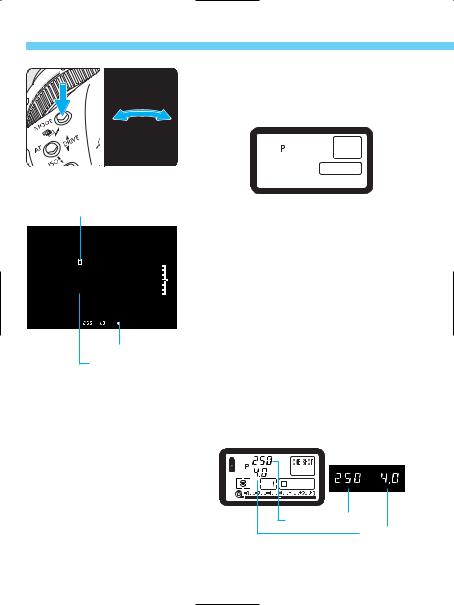
Quick Start with Program AE
Focusing point
In-focus indicator Area AF ellipse
1 Select < > on the LCD panel.
> on the LCD panel.
•While pressing the < 
 > button, turn the <
> button, turn the <  > dial to select <
> dial to select <  >. Then release the <
>. Then release the < 
 > button.
> button.
Focus the subject.
2• Look through the viewfinder and aim the Area AF ellipse over the subject. Then press the shutter button halfway.
 The focusing point which achieves focus flashes briefly.
The focusing point which achieves focus flashes briefly.
At the same time, the green in-focus indicator in the viewfinder is displayed.
 The exposure setting will be displayed on the LCD panel and in the viewfinder.
The exposure setting will be displayed on the LCD panel and in the viewfinder.
•If the in-focus indicator in the viewfinder blinks, the shutter will lock and a picture cannot be taken. See “When Autofocus Fails (Manual Focusing)” on page 47.
Shutter speed
Aperture
Exposure setting
30
